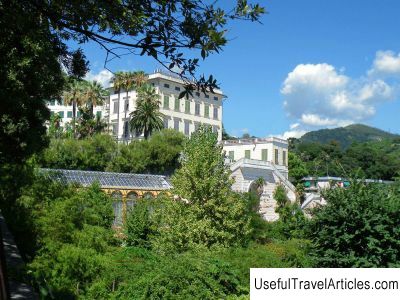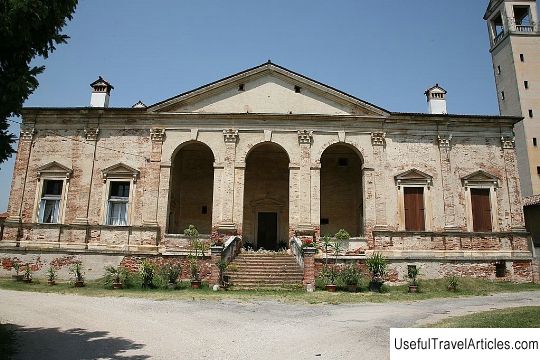Villa Durazzo-Pallavicini description and photos - Italy: Genoa

Villa Durazzo-Pallavicini description and photos - Italy: Genoa. Detailed information about the attraction. Description, photographs and a map showing the nearest significant objects. The name in English is Villa Durazzo-Pallavicini. Photo and descriptionVilla Durazzo Pallavicini, which today houses the Archaeological Museum of Liguria, is located on Via Pallavicini, 13, near the train station of Pella, a suburb of Genoa. The attraction of the villa is a wonderful 19th century English-style park and a small botanical garden. Unlike the museum, the park and garden are open daily. The current estate was built at the end of the 17th century for Clelia Durazzo Grimaldi, who became the founder of the botanical garden of her name. And the park was created by her nephew Ignazio Alessandro Pallavicini after he inherited the villa. The author of the project of the park, laid out in 1840-1846, was Michele Canzio, who also worked on the Teatro Carlo Felice. The park is located on a hill behind the villa and covers an area of 97 thousand square meters. Despite the fact that it is executed in a typical English style, it is quite theatrical - its square is organized as a series of scenes that form a play with a prologue and three acts (Return to Nature, Memory, Purification). The various buildings and statues scattered around the park are also part of this “show.” The park was opened to the public in 1846 on the occasion of the VIII Congress of Italian Scientists and immediately gained international recognition. In 1928, the owner of the park, Matilda Gustinani, presented it to the people of Genoa along with the botanical garden. True, in the 20th century both the villa and the surrounding lands fell into some desolation. They were seriously threatened in 1972 during the construction of a nearby high-speed highway. Fortunately, The historic estate was preserved, and in 1991 it was restored to celebrate the 500th anniversary of the discovery of America by Columbus. Today, most of the park is open to the public. On its territory you can see two ponds, a dozen interesting buildings, various sculptures and a vast grotto, which is Dante's Purgatory. Walking along its covered passages and underground lake, visitors can enter Paradise. Among the buildings of the park, one can distinguish the Coffee House in the form of a triumphal arch, the Madonna's Chapel, the Captain's Mausoleum, the Temple of Diana, the Flower House, the Turkish Temple, the Obelisk and the Chinese Pagoda. And in the botanical garden you can admire araucaria, cedar, cinnamon, palms, oaks and various exotic flowers. and in 1991 it was restored to commemorate the 500th anniversary of Columbus's discovery of America. Today, most of the park is open to the public.On its territory you can see two ponds, a dozen interesting buildings, various sculptures and a vast grotto, which is Dante's Purgatory. Walking along its covered passages and underground lake, visitors can enter Paradise. Among the buildings of the park, one can distinguish the Coffee House in the form of a triumphal arch, Madonna Chapel, Captain's Mausoleum, Diana Temple, Flower House, Turkish Temple, Obelisk and Chinese Pagoda. And in the botanical garden you can admire araucaria, cedar, cinnamon, palms, oaks and various exotic flowers. and in 1991 it was restored to commemorate the 500th anniversary of Columbus's discovery of America. Today, most of the park is open to the public.On its territory you can see two ponds, a dozen interesting buildings, various sculptures and an extensive grotto, which is Dante's Purgatory. Walking along its covered passages and underground lake, visitors can enter Paradise. Among the buildings of the park, one can distinguish the Coffee House in the form of a triumphal arch, the Madonna's Chapel, the Captain's Mausoleum, the Temple of Diana, the Flower House, the Turkish Temple, the Obelisk and the Chinese Pagoda. And in the botanical garden you can admire araucaria, cedar, cinnamon, palms, oaks and various exotic flowers. various sculptures and an extensive grotto representing Dante's Purgatory. Walking along its covered passages and underground lake, visitors can enter Paradise. Among the buildings of the park, one can distinguish the Coffee House in the form of a triumphal arch, Madonna Chapel, Captain's Mausoleum, Diana Temple, Flower House, Turkish Temple, Obelisk and Chinese Pagoda. And in the botanical garden you can admire araucaria, cedar, cinnamon, palms, oaks and various exotic flowers. various sculptures and an extensive grotto representing Dante's Purgatory. Walking along its covered passages and underground lake, visitors can enter Paradise. Among the buildings of the park, one can distinguish the Coffee House in the form of a triumphal arch, Madonna Chapel, Captain's Mausoleum, Diana Temple, Flower House, Turkish Temple, Obelisk and Chinese Pagoda. And in the botanical garden you can admire araucaria, cedar, cinnamon, palms, oaks and various exotic flowers.         We also recommend reading Church of the Intercession of the Virgin in Medvedkovo description and photos - Russia - Moscow: Moscow Topic: Villa Durazzo-Pallavicini description and photos - Italy: Genoa. |




